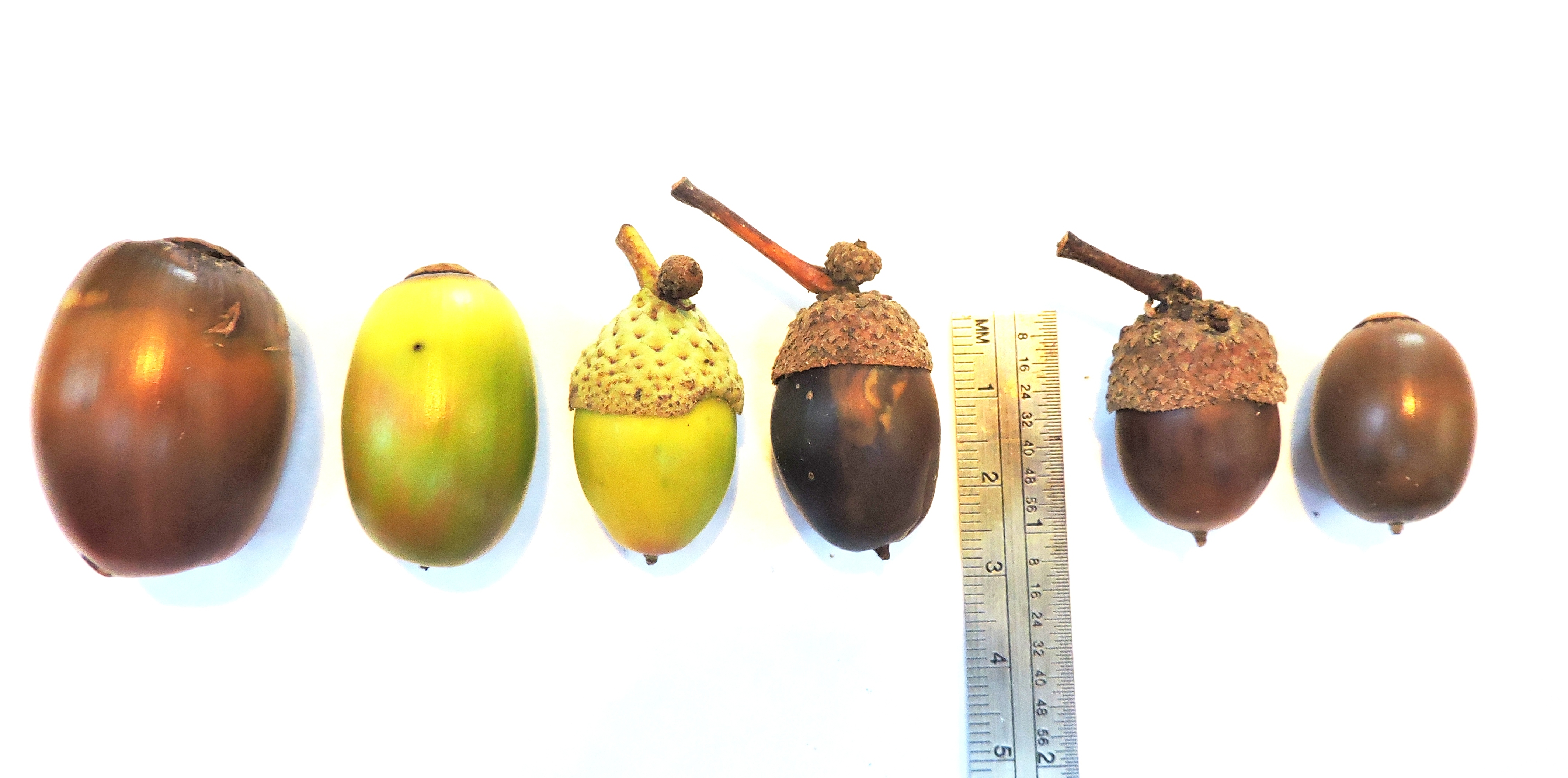
Note: Written below is the process I am using in 2017 for acorns and chestnuts. (Both are recalcitrant seeds.) Down the line, I may revise my protocol further.
SUMMARY: How to Store Acorns and ChestnutsFirst: Collect acorns within 1-3 days of falling, especially if the weather is dry and hot. Second: Bring home only acorns that look dang near perfect. Third: Unless you plan to freeze your acorns, immediately upon arrival let the acorns soak in water 6-8 hours or overnight to rehydrate. Fourth: At the end of the soak, add a small amount of apple cider vinegar to the water, and swish around for a minute or two. Fifth: Cut open a sampling of your floating acorns to see if for this batch floating means “bad acorn.” If it looks like floaters= bad then go ahead and discard your floaters. Sixth: Drain acorns, quick towel dry, lay out in a single layer to let them surface dry a few hours. Seventh: Choose a storage method: I am currently recommending refrigeration in mesh or paper breathable bags but read more below to explore all the options. Eight: If you store acorns more than 2-3 months, you may want to rehydrate the acorns a second time after 1-2 months of storage and another surgical look at the floaters. Please read on to get a full understanding of the acorn process. If you understand acorns beyond this summary list, you are more likely to have success.
|
Acorn Collection and Prep
#1 incredibly annoying fact: acorns are quite perishable.
They fall into a category called “recalcitrant” seeds which means they are fussy about living. They don’t like to freeze, dry out, suffocate, get hot and they get fungus. In other words, acorns are high maintenance.
#2 annoying fact: you can’t easily see what is going on inside the acorn.
You can have rotting, fungusy, weevil-laden, general nastiness in there and you will not know it without cutting open the acorn.
People who collect acorns generally fall into one of two categories:
- Folks in the wild edibles movement who forage acorns as a food for humans. Their goal is long-term storage of acorn that does not necessarily need to keep the acorn alive. They shell and dry the nuts whole, or grind the nuts into a coarse meal and dry the meal. It is a lot of work. But they can store the dried meal for years on the shelf.
- Professional foresters collect acorns in order to create new baby oaks at tree nurseries. They definitely need to keep the acorn alive, so it will sprout into a baby tree. They handle acorns by the truckload sometimes, so they have a lot of mass to manage.
It may initially seem like the acorn-as-human-food goals would be most similar to acorn-as-animal-food goals. But in fact, the forester’s process is closer to what we want to copy, because acorns kept alive in whole form is closest to what wild animals would find in the wild.
Understanding acorns
All oaks are in the genus Quercus and they reproduce by creating embryos in the form of nuts called acorns. Acorns are alive. Acorns live and breathe. Since they have no teeth and claws, acorns defend themselves with have chemicals called tannins. Tannins taste bitter and can be toxic in high quantities for some animals, though it is believed wildlife tolerate this better than domestic livestock.
The acorn is an embryo that comes with its own packed lunch. Left on its own, it will continue to live off its own stores of nutrients until it can sprout, send down roots and start getting nutrients from the soil. So even if all goes well, an acorn will lose weight over time as it eats its own lunch.
In the eastern USA, the Quercus genus subdivides into two large groups: the white oak group (the Leucobalanus subgenus) and the red oak group (the Erythrobalanus subgenus). Acorns from each subgroup grow differently. White oak acorns grow to maturity in a single growing season. The oak flower from last spring becomes the acorn of autumn of the same year it fell off the tree. These acorns have a fast growing energy and often germinate within a month or so of dropping off the tree. If you collect white acorns and keep them alive in your fridge, some may sprout.
Acorns from the red oak subgroup two full growing seasons to create an acorn. The tree flowers and gets pollinated, but the acorn itself does not start to grow much for about 1 year. It stays on the tree all the first winter, continues to grow to full size the second summer and drops off the tree the second autumn. Then, once that acorn falls, it stays on the ground all winter and then sprouts the following spring. Since red oak acorns have to survive so much longer than white oaks before sprouting—both on the tree and on the ground—red oaks have more defensive chemicals (tannins) to help them survive being eaten.
Does it matter to rehabbers if they collect and store acorns from the red oak subgenus or the white oak subgenus? Practically speaking, it depends how long you keep them. Red acorn subtypes store longer because they do not sprout right away. Here are the things you may or may not care about:
- Given pristine, perfect storage conditions, white oak acorns will not survive more than 6 months, though, while red oaks can possible survive a few years. White oak acorns will sprout after about a month in your refrigerator, but still are usable after sprouting.
- People think that animals like white oak acorns because they are less bitter due to less tannins. they see animals going first for white acorns over red acorns in the forest. Animals’ preference could be a taste thing, but it is also a timing thing. White oak acorns fall earlier in the season than the red oaks, so they get eaten first because they are available first. But animals will eat eventually eat all types of acorns, red group or white group.
- The red acorns are slightly higher in fats and whites are slightly higher in carbohydrates.
- Red acorns will not sprout in your refrigerator, so may be the better “storage” acorn.
- Both types of acorns can have larvae form the long-snouted and short-snouted acorn weevil, and these small grubby insects WILL some out of the acorns into your refrigerator or anywhere you store them.
The collection and storage methods I am currently recommending is the same both subtypes.
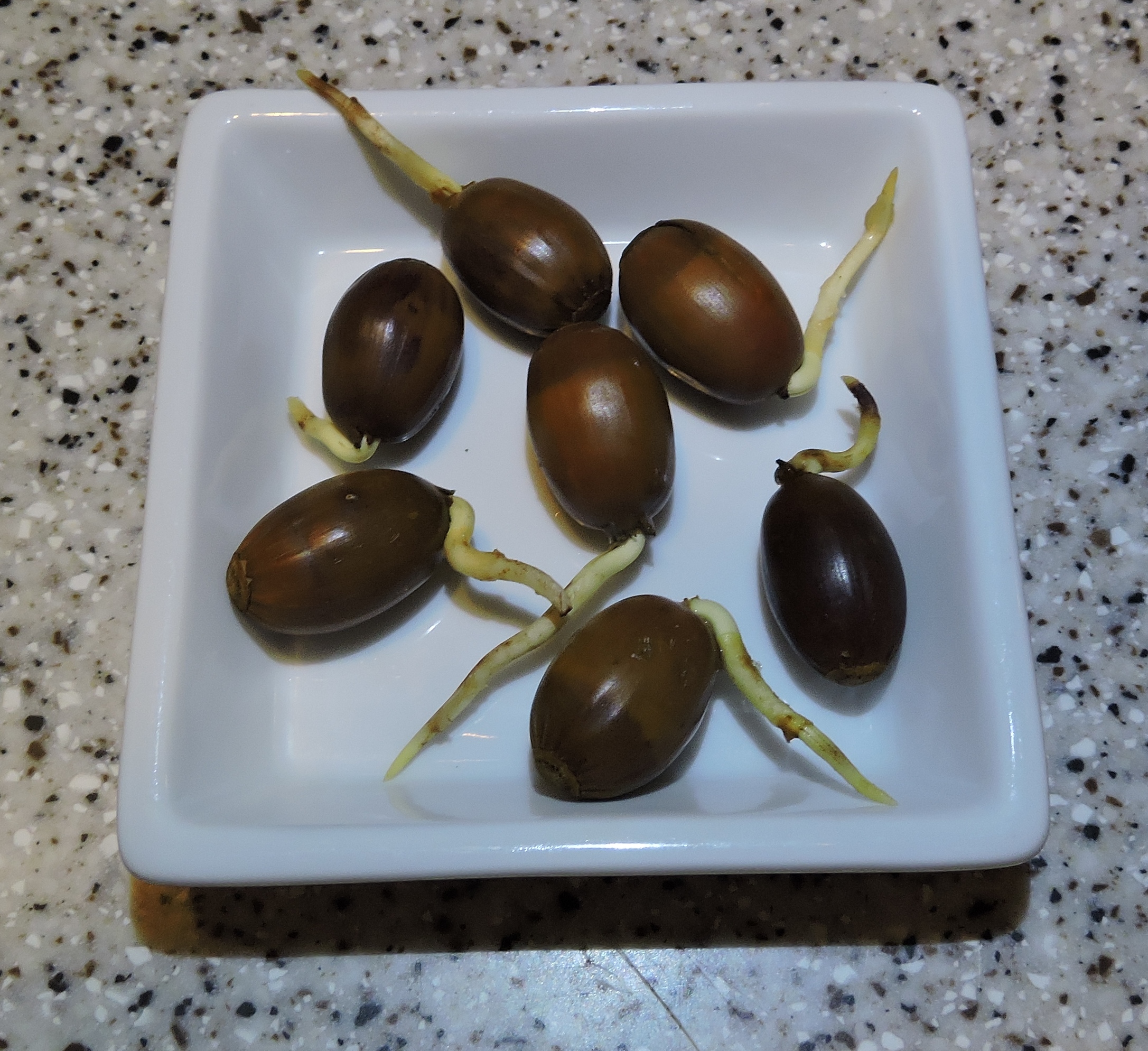
Tannins and Toxicity
Though the tannin content varies across species, all oaks should be considered toxic to animals if fed in too high a quantity. In livestock poisoning cases, this has usually occurred when the animal had access to no other foods except oak. Given as a part of a balanced diet, oak browse and acorns are fantastic wildlife foods.
How does Mother Nature Store Acorns?
She doesn’t, really. Even before they drop, the weevils are eating them. Then the trees throw their acorns down right at the time the animals scarf them up to put on winter weight. Some acorns get smashed in roads, some get picked up by wide-eyed nutters like me. Acorns die from falling into inhospitable conditions—too hot, too cold, too dry. The vast majority of a million acorns a tree may produce over it lifetime either die or get eaten quickly. That’s okay: from an ecological point of view, a tree only has to produce one offspring that grows to full maturity in order to be a reproductive success. So really Mother Nature’s strategy is not about storing lots and lots of acorns long-term. of the two subtypes, red and white, the red store the longest.
So when we try to store acorns, we are trying to do something a little outside of nature’s way. Our best nature model may be the chipmunk. Chipmunks larder their acorns underground where they do not freeze, are cool, moist, and in the dark. Then the chippy hibernates right on top of the acorn stash!
Yet, some acorns do survive in nature for a few weeks or over a winter to sprout into baby oaks. Those acorns survive by being by dropping onto cool, damp soil and getting covered by leaves. The leaves protect from hot sun and dry cold. Then it rains and snows. This keeps acorns moist, cool but not too deeply frozen, out of the wind, but able to breathe.
Acorn Weevils
Insects love the nutritional powerhouse of the acorn as much as the bigger animals. Acorn weevils often get a jump on the acorns while the acorn is still growing on the tree. When an acorn falls off the tree, it probably already has weevil grub living inside, if it is going to. The grub may still be very small and it can be hard to know if it is in there at all.
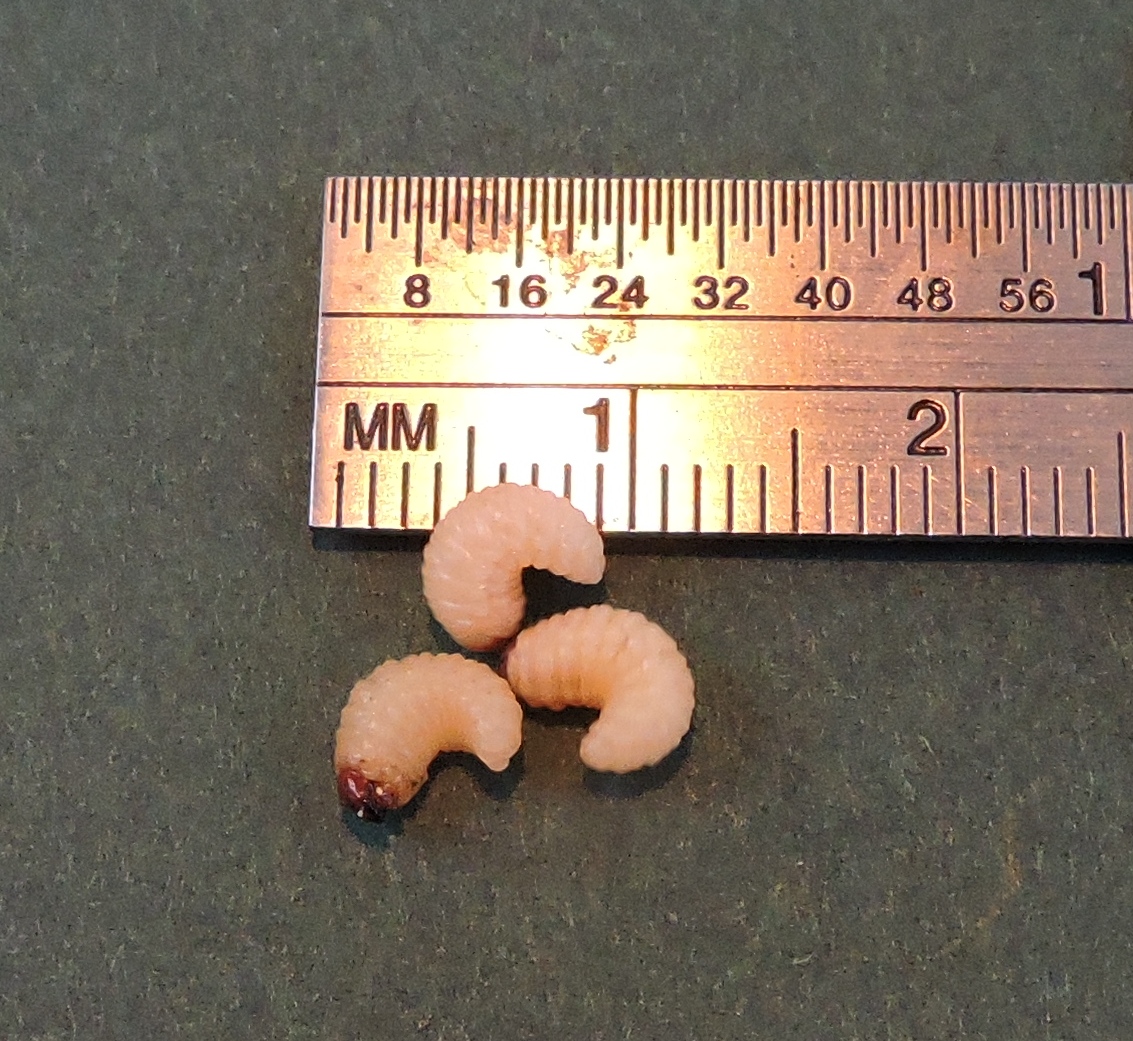
The acorn weevil is an insect which makes a nearly invisible hole in the acorn shell, and inserts it egg inside the acorn so that when the egg hatches, the baby weevil is surrounded by rich acorn foods to eat. Then the baby weevil eats and grows and eats and grows inside the acorn. When fully grown, the baby chews its way out of the acorn, leaving a larger visible hole in the acorn shell which it squeezes itself out. By then, the acorn is pretty empty. And the grub is inside your refrigerator, though it doesn’t crawl around, it just lies there mostly.
As the weevil develops inside and it eats up the acorn meat, the acorn gets lighter and lighter in weight as the nutmeat is used up. When we do “float tests” which you will read about towards the end of this section, we are trying to estimate the weight of the nutmeat inside to see if an acorn is still “good” inside, or gone. If you deep freeze an acorn, the weevil inside will die at whatever stage of development it is at. But there are drawbacks to freezing acorns, even though it does stop the weevil in its tracks.
Collecting Acorns Like a Pro
Since acorns are alive and we want to keep them that way, it is good to try to collect them as soon as they fall from the tree, ideally within a few days. September 1 is the beginning of “nut season” here in western Virginia, and it starts with the white oak subgenus. Especially in early autumn, it can be dry and very hot outside, especially in the sun and acorns can die within days of dropping from dehydrating and getting too hot. Collecting them quickly improves the chances of keeping them alive. Once an acorn dies, like all beings, it starts to rot. The rotting starts on the inside where you cannot see it. Rotting acorns do not make for good eats.
Acorn dissection is a great lesson. Gather about 50 of the best looking acorns you can find from one single species of oak. Look for acorns with no blemishes— which can be hard to find! Samuel Thayer in his excellent book The Forager’s Harvest has the best chapter I have seen on teaching yourself to know a good acorn from a bad one by inspecting each acorn’s features. I highly suggest getting this book and reading his acorn chapter end to end. Then get a sharp knife and cut open all 50 acorns and compare all his pictures with all your acorns so you really teach yourself the external warning signs that indicate the quality of the nut inside.
Then repeat that process for every different species of acorn you intend to collect until you know what to expect from the individual species of oak acorns. I’d love to make this simpler, but I cannot. Acorn quality assessment is a pain, but they are such a prime wildlife food, they may be worth it!
The more I collect acorns, the more I believe it is good to try to only pick up acorns you feel have a strong likelihood of being good. Otherwise, one of two things will happen 1) you will go home and do a “float test”, and you will end up throwing out ½ or more of what you just spent valuable time and effort in collecting. And you will get discouraged. Or #2, you will skip the float test and store everything you have collected and ½ or more of your acorns will be worthless and you will mislead yourself into thinking you have a great quantity of wildlife food when you do not.
Better to go slowly and collect a good product to begin with. I try to not even take home acorns with cracks, breaks, bulges in their cap areas, and holes. For that same reason, I do not rake up acorns. I pick them up individually so I can examine them and toss out the questionable ones onsite.
Arriving Home with Your ‘Corns
Tempting as it may be, do not set your acorn collection in the garage to “get back to in a while”. Those acorns will start to turn to compost on you. Resist stopping at this point.
The first thing you should do when coming home is welcome those acorns into your home and give them something to drink! Hospitality! Fill a bucket with cool water and let your acorns go for a swim for about 6-8 hours. Some may float, some may sink. (No worries. We are not really doing a “float test” yet.) We are just letting them rehydrate after having been separated from their tree and sitting on the ground awhile. (Note: If you plan to freeze your acorns, you should skip this rehydrating step because increasing the moisture content of your acorns then freezing them will lead to even more degraded acorn quality upon defrosting.)
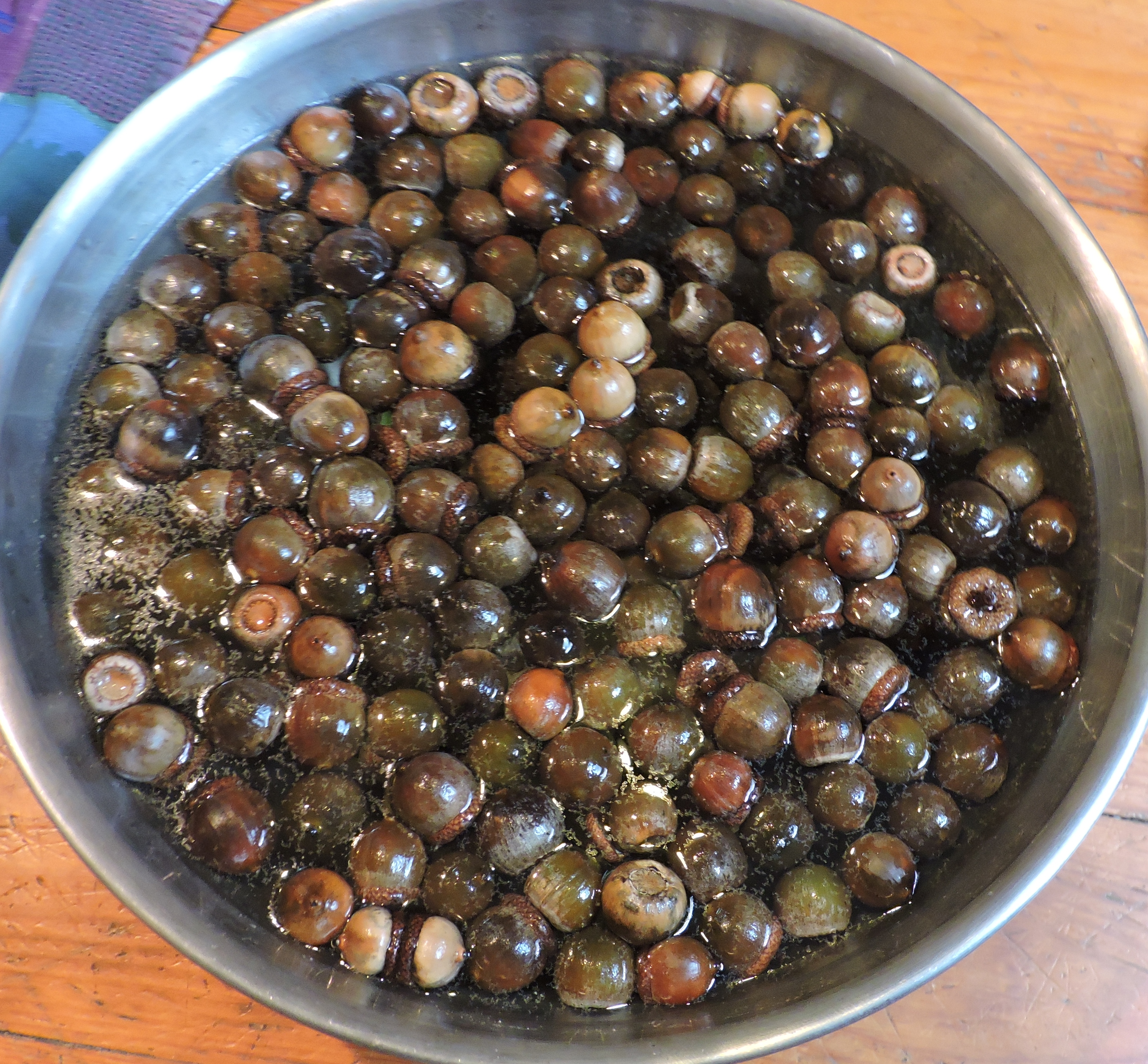
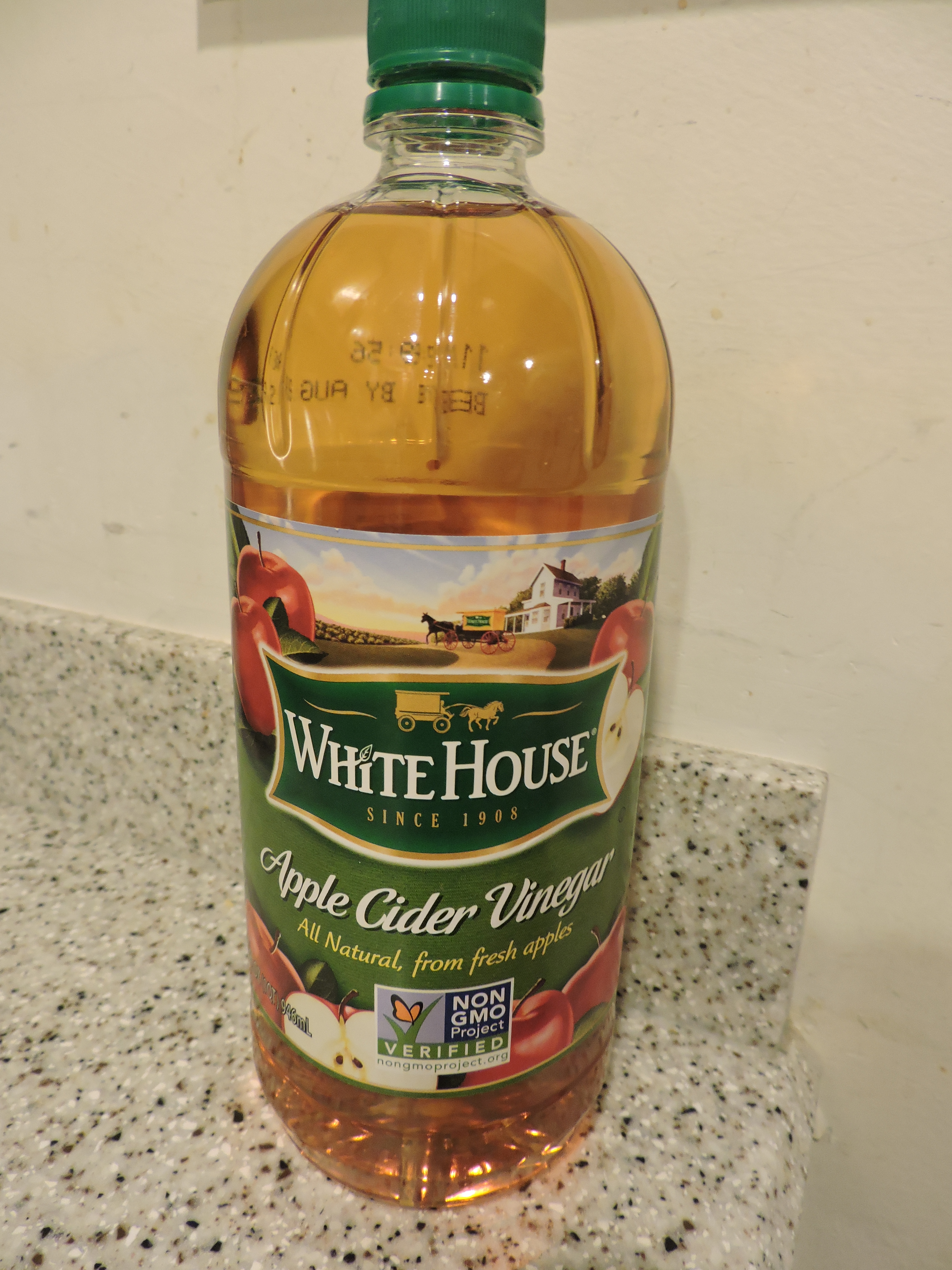
At the very end of their soak, I add about ¼- 1/2 cup of apple cider vinegar to 3 gallons of acorns and water and stir it up so that the acorns get a quick coating of vinegar water. The vinegar hopefully acts as a deterrent to fungal growth as we store the acorns. I don’t want to soak them in vinegar water, just a quick swish at the end. Then I drain the nuts, roll them in a towel , then lay them out to air dry for a few hours, just to get the surface dry before storage.
Jordan Herring, a rehabber at the Wildlife Center of Virginia did some research into this rehydrating step. He consulted with Josh McLaughlin, a Nursery Forester of the Virginia Department of Forestry, who explained the process the department uses to store acorns.
Foresters, who are in the business of trying to keep the maximum number of acorns alive, do this initial swimming session. They also know that in any given batch of acorns, the more time goes by, the more acorns in a batch will die. They get those acorns planted as soon in the fall or following spring that they can. Foresters know that storing acorns and keeping them alive is hard.
I have noticed, however, that after I swim my acorns for about 8 hrs. that more defects like splits or gashes show up because the acorn has swelled some from its swim. Don’t let that those defects worry you too much. Throw out the really bad ones.
What about that “Float Test” thing? What was that? Should I do that?
Many people, including myself at times, have recommended using a “float test” to rough sort your acorns after collection into good and bad piles. The idea is that if a weevil or rot has occurred inside your acorn, the density of the nutmeat will be less and the acorn will float if it is put in water. Heavy, healthy acorns will sink.
It is completely true that bad acorns float. But, unfortunately the corollary is not true. Some good acorns float, too.
I have collected a lot of acorns and have float tested most of them, but now I follow-up and test my float test results for accuracy. For big heavy acorns like chestnut oaks, they sink readily. So when one of them floats, I know to trust that it is bad.
When I float tested a batch of red oak acorns that all looked pretty good to the eye, about 50% floated. So I started cutting open the floaters and I found that maybe ½ of the floaters really were compromised but that other 1/2 still looked good to me. I tried the float test on some good looking pin oak acorns—very small acorns—and 100% floated. Should I have thrown them all out? When I cut a sampling of them in halves, I found only 1/8 of the pin oaks were bad. So if I had followed the float test, I would have thrown out a lot of good acorns. Pinoaks are just really small acorns to begin with, so they don’t have much heft.
The upshot is, it seems the float test works most accurately on larger, heavier acorns. Smaller, or drier acorns that have started to lose moisture may still be good but fail the float test. I think the first time you collect any given species, you need to check the results of your floaters and see if the “floating is bad” rule really applies to that particular species.
If you want to do a float test, consider the end of your overnight soak to be your float test. Cut a few of those floaters open to assess them at the end of the 6 hour soak.
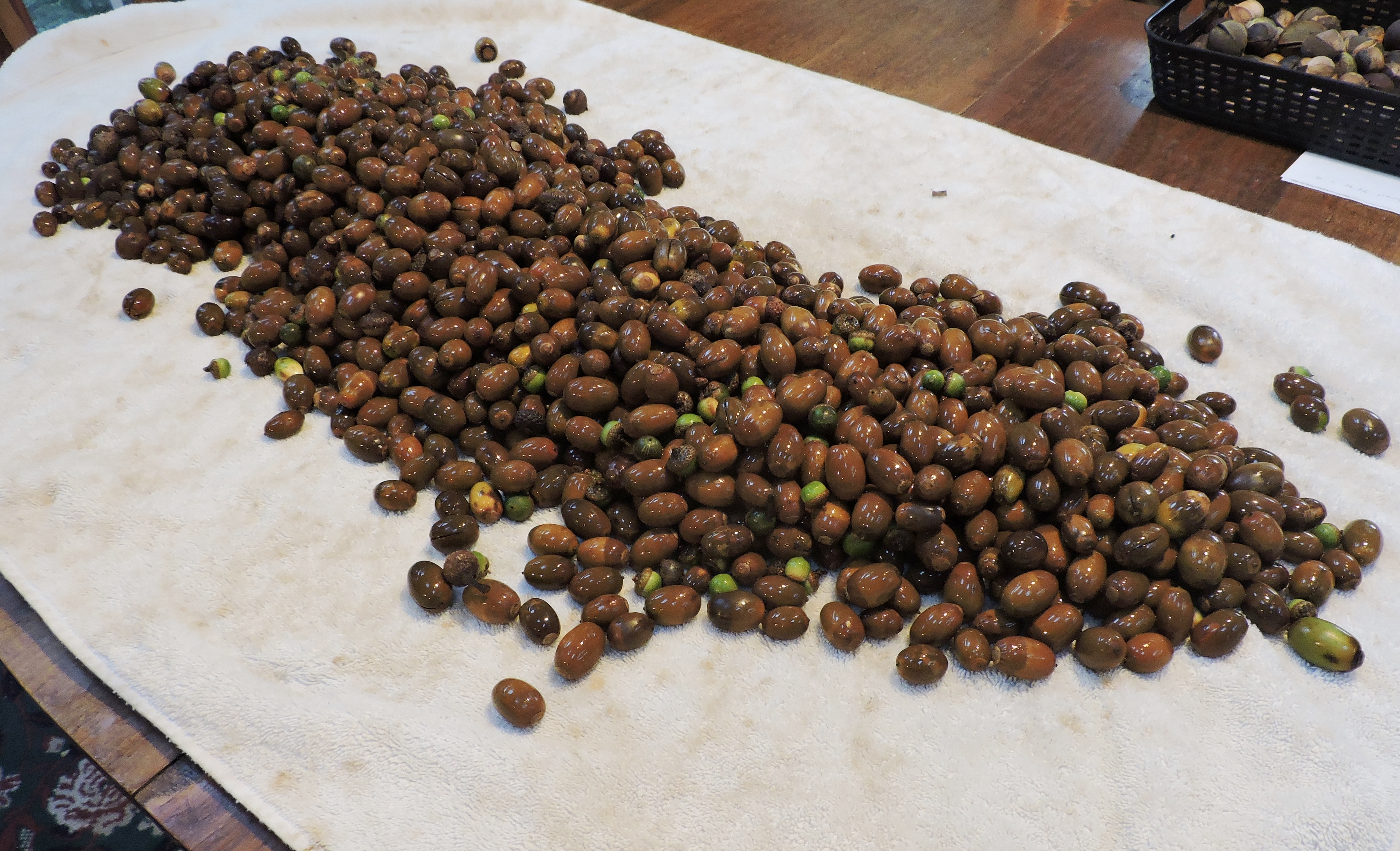
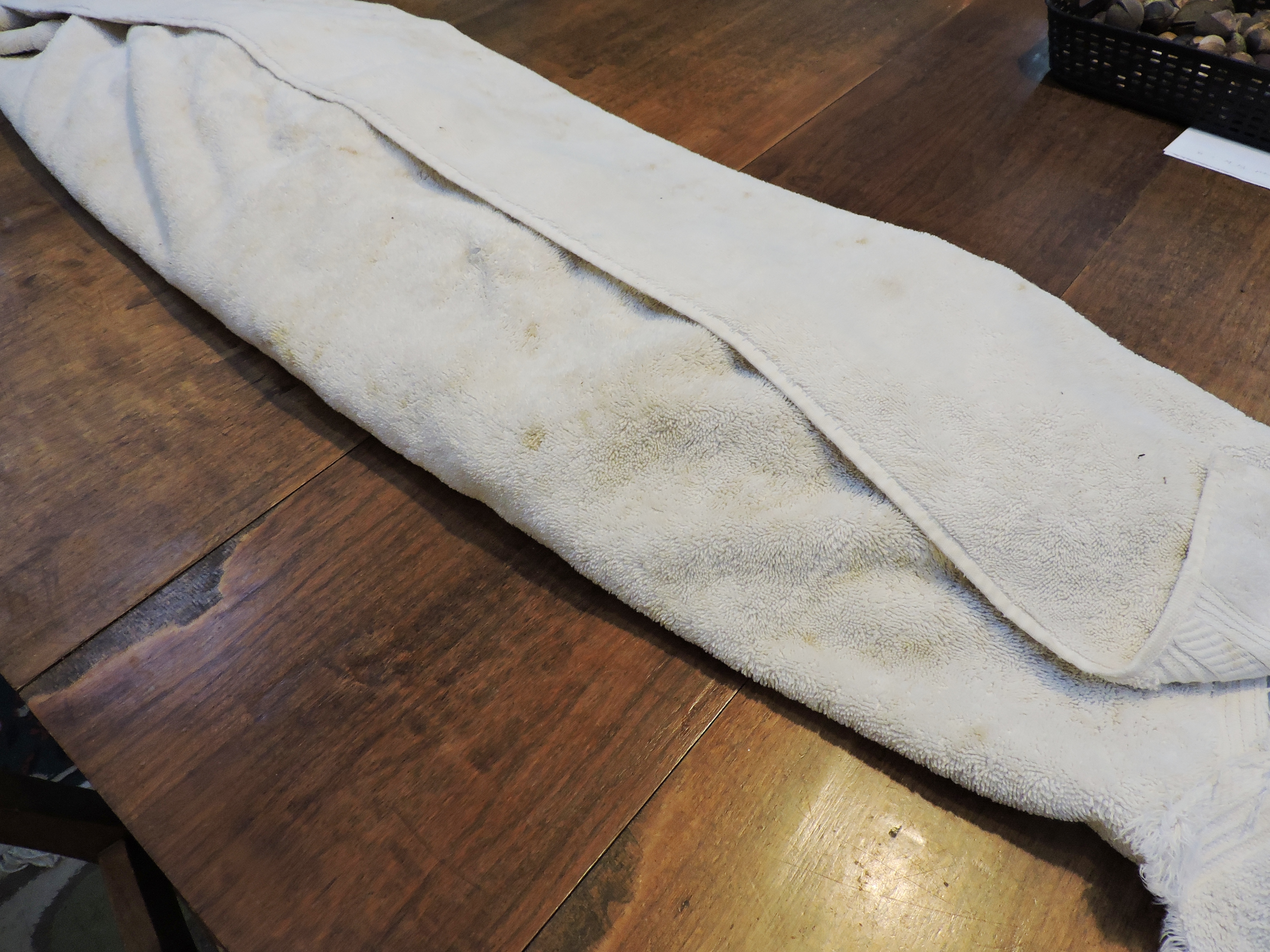
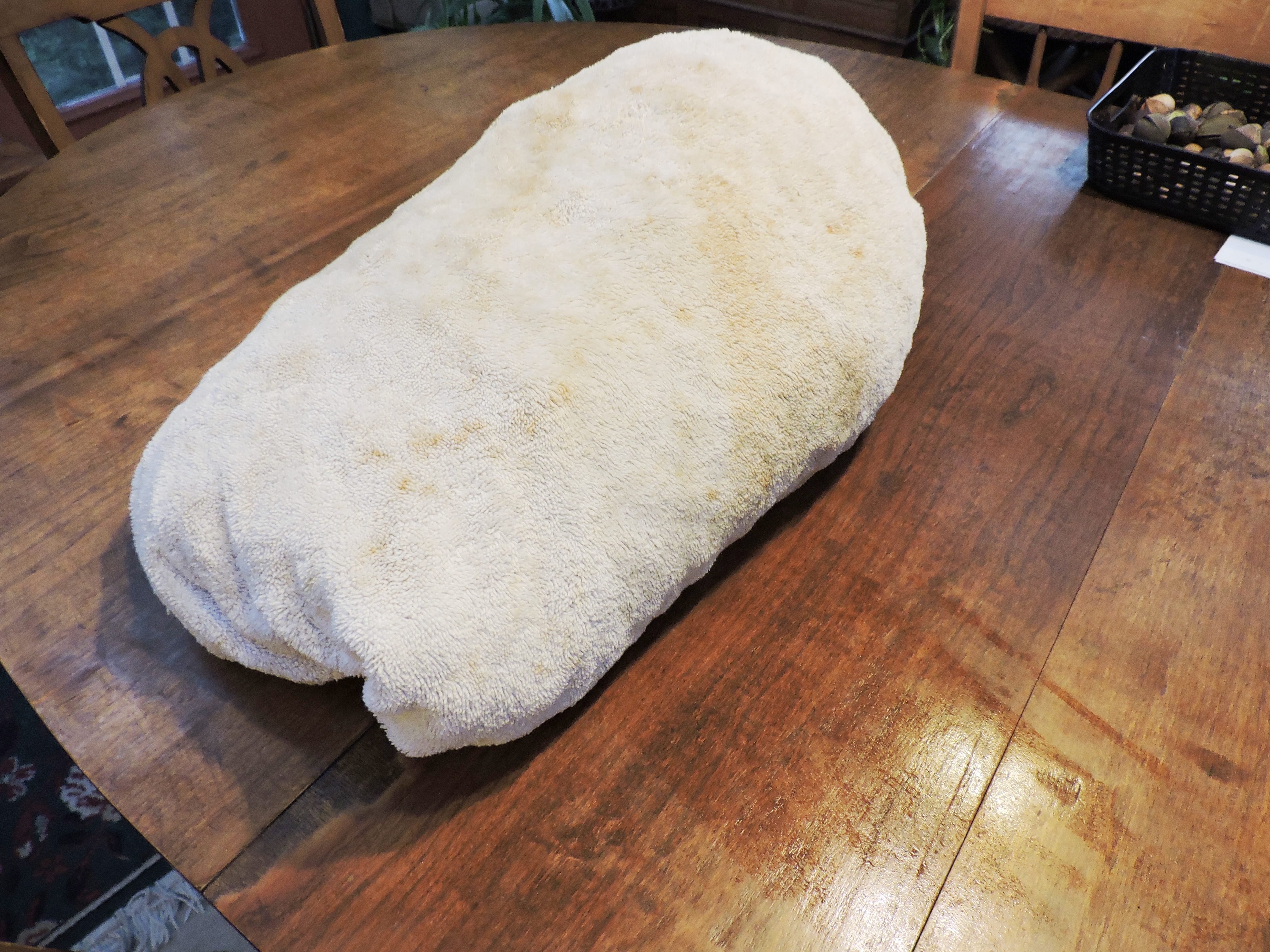
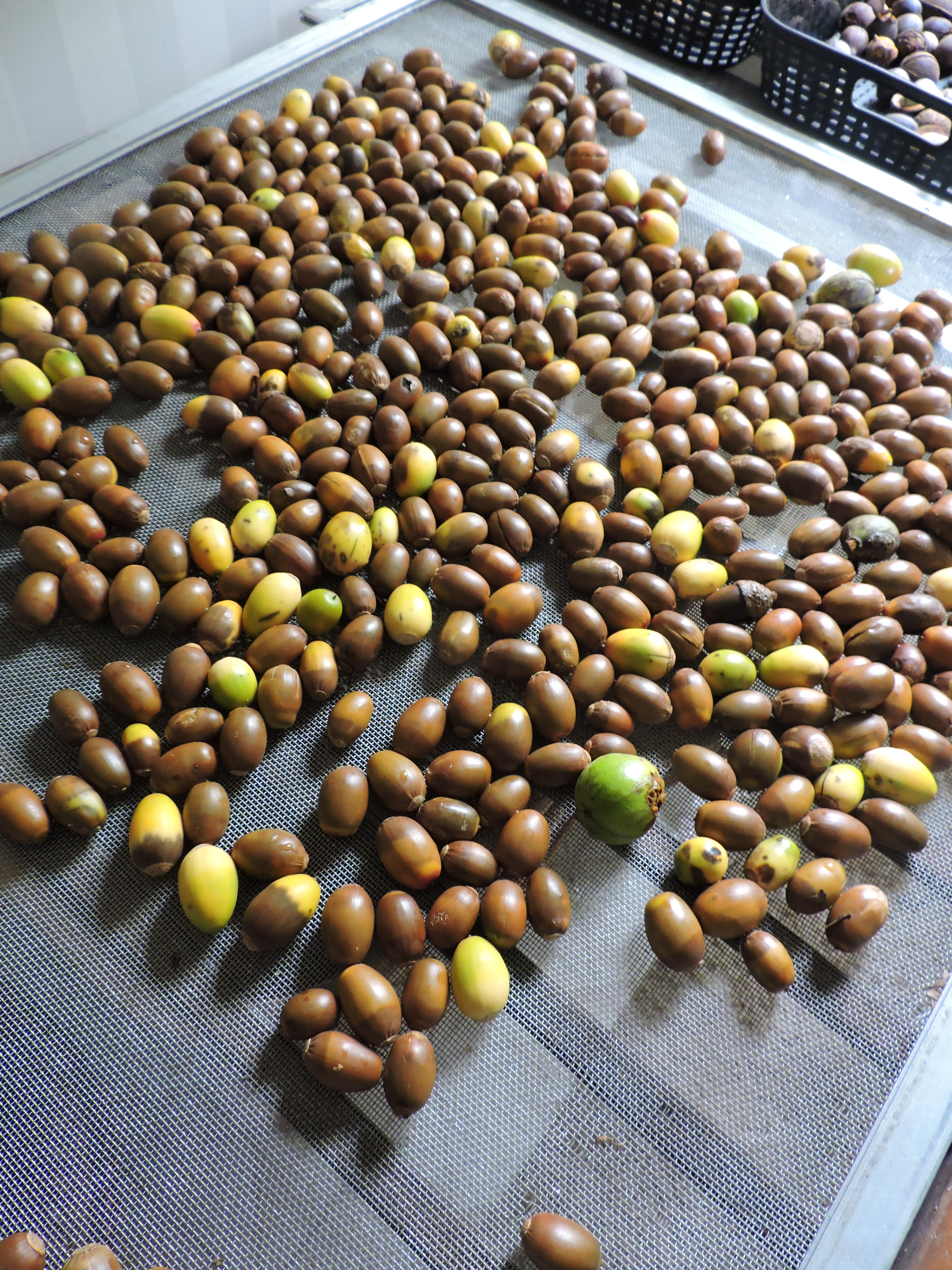
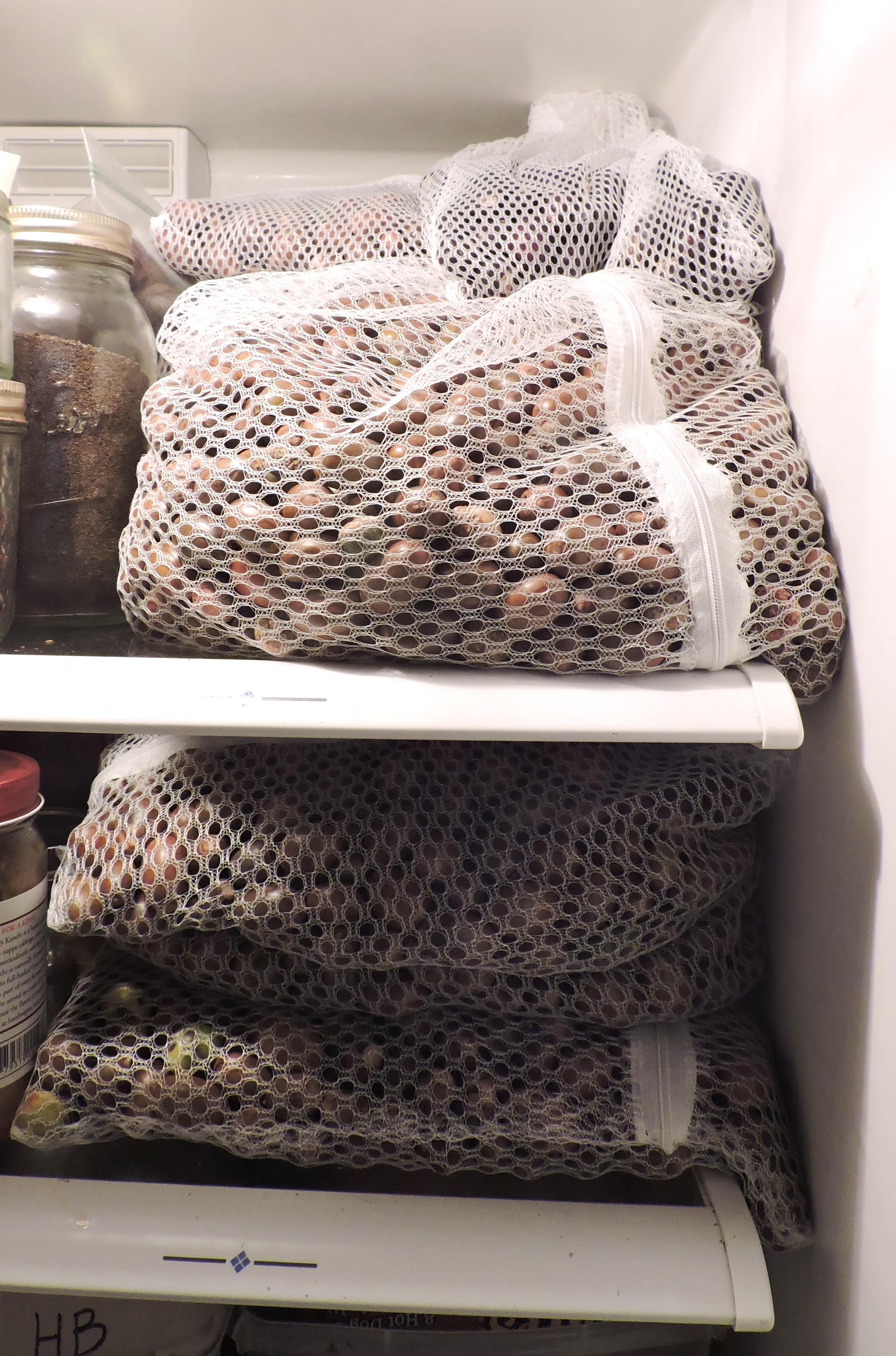
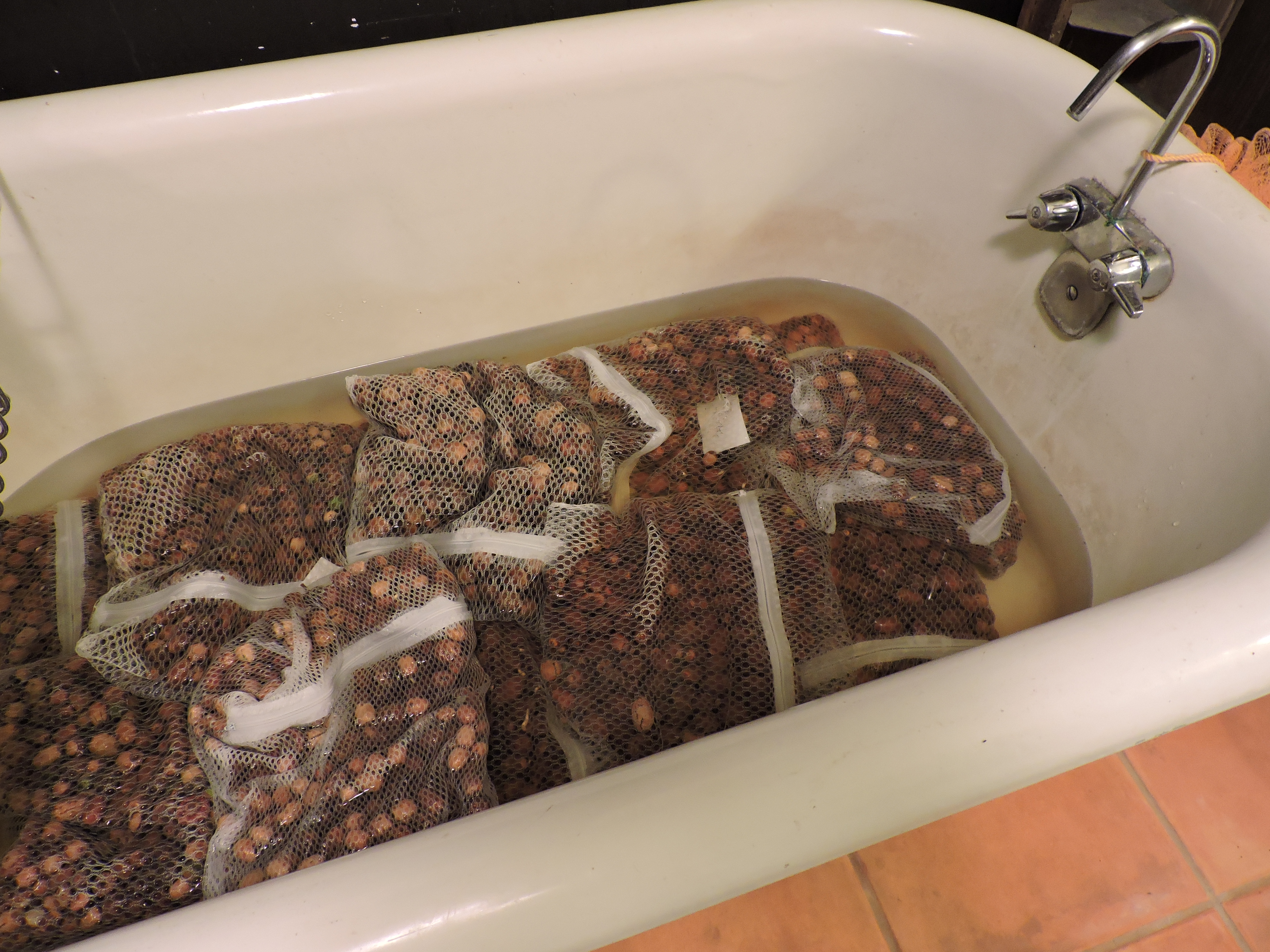
All this, just to get to the section on how to store your acorns! I’ll lay out the chart of options, and help you think through the pros and cons of your choices. And I will keep doing experiments on my own and may revise my recommendations down the line. But even if I could say what is best, you have to figure out what is best for you. Because you may have freezer space, but no refrigerator space, or you may only need to store for 2 months instead of 6 months.
The mantra for acorn storage is Cool. Moist. Breathable.
- Acorns need to stay moist. Dry acorn=dead acorn.
- Overnight soak when you bring them home helps. Refrigerators tend to be moist environments, but if you store your acorns more than a month, you may want to rehydrate them again 1/month with a soak or a spray down with water.
- Acorns need to breathe. No air over time=death.
- Plastic bags and airtight containers preserve moisture, but cut off air. Store nuts in breathable mesh, fabric or brown paper bags. I can buy 3 zippered “delicate laundry’ bags for $1 at Dollar Tree that each hold about 1 gallon of acorns.
- Moist acorns are prone to fungus.
- Weak vinegar solution added to end of rehydrating soak to help retard fungus.
- Frozen acorn=dead acorn. (But cool acorn, 32-38 degrees F = slower metabolism= good.)
- You need a refrigerator that can control the temps for a space packed densely with acorns without over-cooling and freezing the nuts. Acorns can take a quick, brief freeze, but long deep freezes will kill them. However—especially for the white subgenus acorns which are revved up metabolically to sprout quickly— cooler temps will slow the acorn’s metabolism down from burning through its own internal sugar stores, which will help extend its life
Now, Onto the Acorn Storage Options
| Acorn Storage Options | Pros | Cons | Conclusion | |
| #1 | Refrigerate: Bag acorns in air-permeable mesh, brown paper or fabric bags and store in fridge between 33-38 degrees with air space between bags. Rehydrate every 1-2 months. | Acorns can breathe and stay cool. | Chances of fungus increases over time due to acorns being so close together.
Weevils will stay alive and grow inside acorns, decreasing the acorn quality over time. You will see weevil larvae out of the acorns and inside your refrigerator. |
My preferred method. |
| #2 | Refrigerate : Bag acorns in ziplocs and store in fridge. | Acorns will eventually die for lack of breathing, but will be slower to rot than if they were not refrigerated.
Bags will catch weevil grubs when they come out of acorns. |
Airtight= death. Once dead, the moisture trapped inside the ziplocs may increase rotting.
|
Might work if you can use acorns within a few weeks of initial bagging? |
| #3 | Freeze acorns in ziploc bags. | Simply the easiest thing you can do.
Will kill any weevil grubs inside acorn. No loose larvae in fridge. May preserve the nutritional value of the nutmeat. |
Nutmeat will be mushier once it thaws.
Freezing kills the acorns for sure.
|
We did this for years at the Wildlife Center of Virginia while we were trying to figure all this out. It seemed the only practical way to handle hundreds of pounds of donated acorns. |
| #4 | Freeze-Dry acorns | May work well, we did this in an experiment at Bridgewater College to analyze nutritional preservation of acorns. | No one has that fancy expensive freeze-dry equipment. | Not really an option. |
| #5 | Shell acorns and dry whole or and grind them up in a food processor, then dry the meal. Dry in an oven, or by a woodstove. | This is the wild edible human forager method.
It works at preserving the nutmeat, though the acorn dies. Acorn, if ground into meal, will not look like a nut to an animal. You do have to reconstitute/ rehydrate the dried acorn or acorn meal before feeding it to animals. |
Super labor intensive.
Would provide a safe and nutritionally sound product. Room-temperature stable for years. |
I don’t think I’d do this for this application. Too time-consuming. |
| #6 | Leave acorns in a bucket in the garage. | They’ll basically die from overheating and drying, they’ll compost themselves and rot, and/or rodents will get in them. | No upside to this method. | A waste of your time and resource. |
Freezing acorns
If you DO decide to freeze acorns, know that the second you defrost them you start the clock on them rotting (because they are dead). So defrost and use right away or keep frozen.
